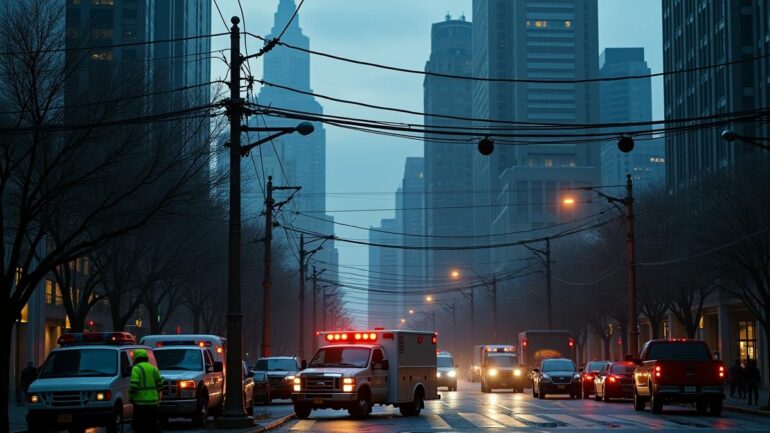In urban areas, modern city life heavily relies on stable electricity, making widespread power failures disruptive. Streets go dark, public transit grinds to a halt, and businesses lose productivity in a matter of seconds. It’s a stressful situation that can happen for a variety of reasons, and each instance highlights the complexity of maintaining uninterrupted power in densely populated areas. From aging infrastructure to cyber threats, each risk factor demands careful planning and swift intervention. A single event can ripple through entire neighborhoods, disrupting daily routines and testing the resilience of local resources.
Key Factors Behind Major Outages
The stability of any city’s electricity grid rests on multiple components working in harmony. When one piece fails, it often triggers a chain reaction that can lead to widespread darkness. In many cities, power companies face the challenge of balancing growing energy demands with the limitations of older utility networks. This balancing act isn’t simple, and the struggle to maintain top-tier electric service grows more daunting as the city rapidly expands.
Aging Infrastructure and Maintenance Issues
Some urban areas rely on decades-old power lines and transformers, which are more prone to malfunctions than modern equipment. Maintenance teams might scramble to address critical parts of the grid, yet frequent repairs can only patch the system for so long. If certain components become severely worn, the risk of a neighborhood-wide blackout spikes.
It’s not simply about rusty transformers and frayed wires. Many parts of a city’s infrastructure are interconnected, which means minor equipment failures can spread. Even a small fault in an older section of the grid may escalate into a full outage if not resolved quickly. The resources required to replace aging parts are also significant, often tying up both funds and workforce for lengthy periods.
Surges in Energy Demand
Sudden spikes in electricity consumption often stress the entire power network. Hot summers push air conditioners to the limit, while freezing winters overload electric heaters. When too many people turn their devices on at the same time, voltage can drop dramatically, resulting in rolling blackouts or targeted shutdowns to protect the grid from total collapse.
Energy providers work to anticipate these surges with comprehensive forecasts and grid management techniques. Yet, unpredictable events or extreme temperature swings can still catch system operators off guard. In such cases, partial shutdowns become a strategic approach to prevent even bigger disruptions. While necessary, these deliberate outages generate frustration among residents who rely on continuous power to keep their routines running smoothly.
The Influence of Rapid Urban Development
A booming city often sees new housing complexes, factories, and commercial buildings popping up. Each new construction project adds to the load placed on existing power lines and substations. Expansion requires massive energy to power everything from heavy machinery to entire floors of office computers. If local planners don’t coordinate with power providers, demand can spike faster than the grid can handle.
Rising skyscrapers, bustling tech parks, and large retail spaces require stronger infrastructure to keep the lights on. Failure to match this demand with adequate upgrades can make the city’s electrical system even more fragile. In the rush to develop, corners may be cut or timed poorly, piling on the stress that older grids already endure.
Natural Hazards and Weather Extremes
Severe weather wreaks havoc on power lines, transformers, and distribution nodes. High winds can knock down cables, intense lightning can zap transformers, and heavy snow can weigh down wires until they snap. Floods present a different challenge altogether, as water infiltration can damage underground cables and substations.
Whenever mother nature strikes, repair crews often face treacherous conditions in their bid to restore power. Rainy scenes, blocked roads, and downed trees complicate the process. The result can be blackouts that last several days, leaving thousands struggling with no heat, refrigeration, or lighting. Emergency measures and backup generators flow into action, but these are often temporary fixes until the weather stabilizes.
Climate Stress and Unexpected Shifts
Climate change frequently fuels weather extremes that push regional power grids to the brink. Longer, hotter summers send energy requirements soaring, which can force older systems to run beyond their designed limits. Meanwhile, heavy storms pummel lines and towers, increasing both the frequency and duration of outages.
Urban planners, energy experts, and local governments track these climate trends closely, trying to bolster the grid’s defenses. The process can be slow, due to funding constraints and logistical hurdles. Even so, the push to integrate renewable energy with existing systems continues, aiming to create a more resilient infrastructure capable of withstanding wild weather swings.
Cyber and Physical Security Threats
Modern electrical systems rely heavily on digital controls. Substations and transformers communicate through networks that allow remote monitoring and quick responses to issues. Unfortunately, this connectivity opens the door to cyber-based interference. Hackers with malicious intent can exploit system vulnerabilities to trigger blackouts or disrupt vital control functions.
Physical sabotage, while less likely, is still a concern. Intentional damage to substations or transmission lines can spark immediate power loss. Security measures like surveillance cameras, restricted access, and robust firewalls are critical. Although such incidents are rare, the impact can be immense, especially in places that are highly dependent on continuous electricity.
The Role of Grid Management Teams
Operators and technicians constantly track real-time power usage across a city. They respond quickly to abnormalities, adjusting voltage and rerouting energy through alternate pathways if a problem emerges. During delicate moments like peak demand on a hot summer afternoon these teams remain on high alert.
Their effectiveness relies on accurate data and strict protocols. When something does go wrong, how fast they diagnose and repair determines the scope of the blackout.
Coordination with Government and Regulations
Many regions have strict rules addressing how power companies should maintain and upgrade their grids. Regulators often impose deadlines or penalties to ensure compliance. Governments also play a role in coordinating emergency responses when a significant outage hits.
Not all cities operate under the same set of guidelines or budgets, which can create inconsistencies in preparedness. One area might have advanced contingency plans, while a neighboring district may lag behind. These discrepancies highlight the importance of clear communication between municipal authorities, power suppliers, and the communities they serve.
Funding and Public Investments
Modernizing the grid can be expensive. It often involves replacing outdated equipment, adding smart metering, or creating new transmission lines. Public-private partnerships sometimes finance these projects, sharing the burden across multiple stakeholders.
Even then, budget constraints can weaken best intentions. The result may be patchwork solutions that only temporarily relieve stress on the grid. Without consistent investment, small-scale disruptions can evolve into larger blackouts. Ensuring politicians and community leaders prioritize infrastructure remains essential if cities are to reduce the chances of widespread power failures.
Future-Proofing Amid Rising Demands
Engineering breakthroughs and technological advancements offer new ways to defend against outages. Smart grids, advanced battery storage, and real-time data analytics can help redistribute energy more efficiently. In certain cities, renewable power sources like solar and wind are integrated to diversify supply.
Yet innovation alone doesn’t guarantee stability. Skilled workers must implement these solutions correctly and maintain them over time. With the right strategy, an upgraded network can adapt to population growth, extreme weather, and changing regulations. The goal is to create a robust system that continues operating under pressure.
The Human Element
Citizens also play a role in preventing major outages. Reducing personal energy consumption during peak periods can lessen strain on the grid. Simple steps like turning off lights, adjusting thermostats, and maintaining appliances can collectively make a difference. If residents understand the fragility of the infrastructure, they’re more likely to support efficiency efforts.
Educating the public to prepare for possible blackouts is another crucial piece. Knowing how to store perishable goods, charge devices, and keep backup lighting on hand helps individuals get through short-term outages more smoothly. Even so, the emphasis on prevention through consistent grid improvements remains the most sustainable path forward.
Resilience Through Ongoing Adaptation
Like any critical system, power delivery evolves with technology, policy, and environmental shifts. Each city’s situation is unique, shaped by growth rates, climate factors, and available resources. Engineers and municipal leaders look for the best blend of upgrades and strategies to keep services online.
No solution can eliminate blackouts altogether, but strategic planning helps reduce both their frequency and impact. By improving infrastructure, addressing security risks, and engaging communities, urban power networks can remain stable in the face of constant change. Empowering repair crews and grid operators with new tools also helps them respond swiftly during emergencies, minimizing the disruption felt by thousands of households.
Balancing Hope with Action
Cities keep changing, and electricity demands follow suit. While no blueprint completely guarantees zero outages, better coordination, modern tech, and robust policies can steer an urban center in the right direction. Planners and residents alike discover that power grids require ongoing attention, precisely because of how deeply they enable daily life.
Protecting against widespread power failures means recognizing the delicate interplay between infrastructure, climate, technology, and community behavior. There’s no single fix, but a balanced approach involving maintenance, innovation, and cooperation can pave the way for fewer blackouts and safer urban living.




